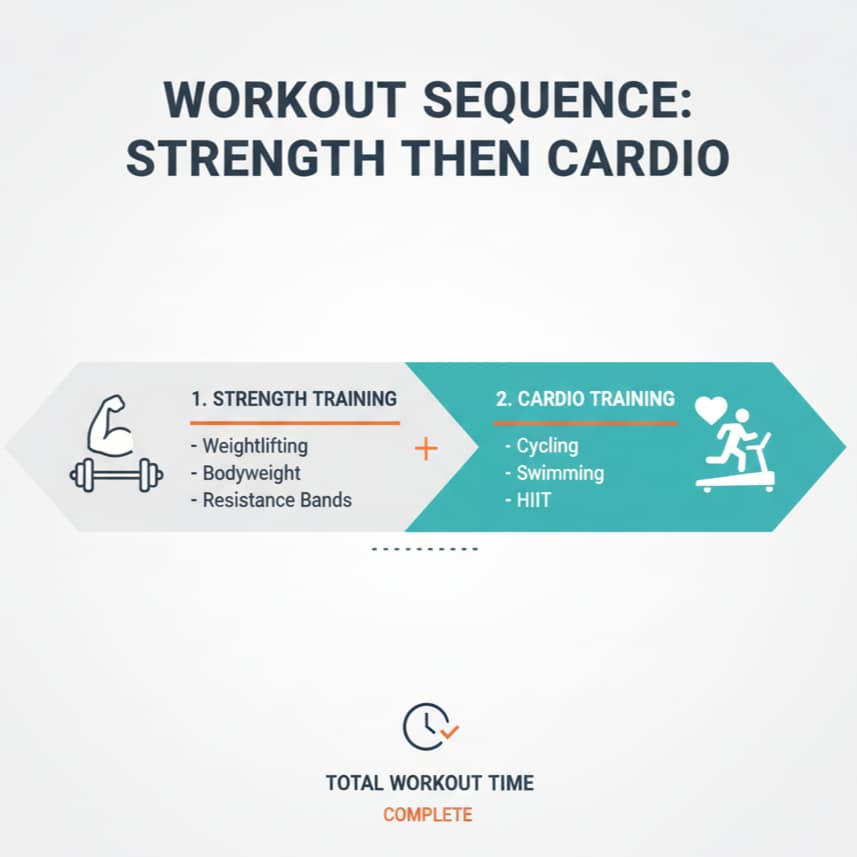Fat loss is one of the most misunderstood goals in fitness. For years, people have argued whether strength training vs cardio for fat loss produces better results. Cardio burns calories quickly, but lifting weights builds muscle that keeps burning fat around the clock. The truth lies in how your body reacts to each method and how you combine them. Let’s break down what science and experience reveal about which one truly wins the fat loss battle.

Table of Contents
Understanding the Basics of Fat Loss
How Fat Loss Really Works
Fat loss happens when you consistently burn more energy than you eat. But it’s not just about calories in versus calories out — your training method changes how your metabolism behaves. Cardio and weight training use different fuel systems and trigger unique hormonal responses. Cardio primarily burns glucose and fat during the session. Strength training, however, builds lean tissue that increases calorie burn for days after your workout.
This difference explains why two people eating the same amount can lose weight at different speeds. Muscle mass acts like an internal furnace. The more muscle you have, the more fat your body burns naturally — even at rest.
Why the Type of Exercise Matters
If you rely only on cardio, you’ll certainly burn calories, but your muscle mass might decrease over time. That reduction slows metabolism, making fat loss harder. On the other hand, strength training preserves muscle and promotes hormonal balance that keeps fat loss steady.
So, while both methods help, choosing the right one depends on whether you want temporary calorie burn or long-term body recomposition.
Strength Training for Fat Loss
How Lifting Weights Burns Fat
Strength training forces your muscles to work against resistance. That process not only strengthens muscle fibers but also boosts your metabolism for hours afterward. Every rep breaks down muscle tissue slightly, and rebuilding that tissue burns energy even when you’re resting.
Research shows that individuals who lift weights three times per week maintain lean muscle while shedding body fat more effectively than those relying on cardio alone.
👉 Read: How Strength Training Boosts Metabolism

The Afterburn Effect Explained
After intense lifting sessions, your body experiences EPOC — Excess Post-Exercise Oxygen Consumption. This means you continue burning calories long after your workout ends. Unlike cardio, where calorie burn stops once you cool down, lifting causes your metabolism to stay elevated for up to 48 hours.
This “afterburn” is why many trainers call lifting a metabolic powerhouse. It’s one of the few ways to burn fat without cardio and still achieve visible results.
Cardio for Fat Loss
How Cardio Burns Calories
Cardio directly increases your heart rate and oxygen demand, burning energy immediately. Running, cycling, or swimming are great examples of workouts that torch calories quickly. Cardio is also effective for improving endurance and cardiovascular health — essential for overall fitness.
For beginners, cardio is often easier to start and provides a quick way to create a calorie deficit. High-intensity intervals (HIIT) can amplify fat burn by alternating bursts of effort with short rests.

Why Too Much Cardio Can Backfire
Despite its benefits, excessive cardio can backfire. Long sessions increase cortisol, a stress hormone that promotes fat storage and muscle loss. Over time, this can slow your metabolism. Without sufficient resistance training, your body starts using muscle for fuel, leading to a “skinny fat” look.
Moderation is key. Two or three cardio sessions per week complement strength training perfectly. More than that may stall results.
Strength Training vs Cardio — Scientific Comparison
Research on Fat Loss Efficiency
Multiple studies have compared cardio vs resistance training head-to-head. While cardio burns more calories during the session, resistance training leads to greater long-term fat reduction and body composition improvements.
For instance, a Harvard study found that people who lifted weights 30 minutes a day had less abdominal fat gain over time than those who only did cardio. Strength training increases metabolic rate, while cardio mainly affects immediate calorie burn.
👉 See: Strength Training for Beginners — Fat Loss Focus
Hormonal Impact and Recovery
Your hormones play a big role in how you lose fat. Strength training boosts testosterone and growth hormone—both vital for building muscle and burning fat. Cardio, on the other hand, primarily raises cortisol levels when overdone. Too much cortisol can cause fatigue, poor recovery, and stubborn belly fat.
Balancing these hormones is key to success. That means pairing smart resistance work with enough sleep, nutrition, and recovery.
👉 Related: Recovery and Hormonal Balance in Fat Loss
Cardio or Weights for Weight Loss — Which Comes First?
Ideal Workout Order
If you’re combining both, start with weights first. Research shows that strength work depletes glycogen stores, so your body taps into fat during subsequent cardio. Doing cardio first may drain your energy and reduce performance during lifting.
In simple terms: lift first, run second. This order maximizes fat oxidation and muscle preservation.
How to Combine Both in a Routine
A balanced plan for the best fat loss workout includes three resistance sessions and two moderate-intensity cardio days each week. One HIIT session can be added for efficiency. The goal is consistency, not perfection.
👉 Explore: Combining Strength Training and Nutrition
When combined with a protein-rich diet and slight calorie deficit, this structure ensures steady, sustainable fat loss.
Female Fat Loss — Strength Training vs Cardio
Myths About Women and Weightlifting
Many women fear that lifting weights will make them bulky. That’s false. Due to lower testosterone levels, women build lean, toned muscles rather than bulk. Strength training also prevents metabolic slowdowns and bone density loss—issues that affect women more with age.
Women who lift report better body confidence, higher energy, and stronger mental resilience. Cardio alone can’t deliver those benefits.
Tailoring Fat Loss Workouts for Women
For women, the key is progressive overload with moderate weights and compound lifts like squats, presses, and deadlifts. Adding two light cardio days helps with endurance and recovery.
👉 See: Strength Training for Different Body Types
This approach balances muscle tone and fat burn, producing long-lasting results without overtraining.
Burn Fat Without Cardio — Is It Possible?
Fat Loss Through Resistance Alone
Yes, you can lose fat without cardio. Strength training triggers the same calorie deficit through muscle building and repair. When you increase lean muscle mass, your resting energy expenditure rises, making your body burn fat more efficiently—even on rest days.
👉 Read: How Muscle Helps with Weight Management
A simple full-body plan performed three times weekly can transform your body composition without a single treadmill session.
Nutrition and Recovery as Key Fat Burners
Even the best workouts won’t matter if your diet isn’t aligned. Eating enough protein, managing stress, and sleeping 7–8 hours each night support hormonal balance. Without these, fat loss slows regardless of exercise style.
Your body doesn’t just lose fat in the gym—it happens during recovery. Recovery determines progress.
Best Fat Loss Workout Plan (Science-Backed)
Weekly Training Template
| Day | Workout Type |
|---|---|
| Monday | Strength (Full Body) |
| Wednesday | Cardio (HIIT 20 mins) |
| Friday | Strength (Lower Focus) |
| Saturday | Active Recovery (Walk or Yoga) |
Common Mistakes to Avoid
Two major fat loss mistakes are skipping recovery and under-eating. Your metabolism needs fuel to burn fat effectively. If you restrict calories too hard or train without recovery, your body adapts by conserving energy.
👉 See: Common Strength Training Mistakes During Fat Loss
The solution: consistent training, balanced nutrition, and steady progression.
👉 Learn More: Progressive Overload and Fat Loss
Conclusion: What’s the Verdict?
In the debate of strength training vs cardio for fat loss, strength training takes the long-term win. Cardio burns calories now, but lifting changes your body’s entire metabolism. For the best results, combine both. Lift heavy to build lean muscle, add moderate cardio for endurance, and focus on recovery and nutrition. Sustainable fat loss isn’t about endless sweat—it’s about smart strategy, progressive overload, and consistency.
Strongil’s approach remains the same: evidence first, results always.
Strength training vs cardio for fat loss Reddit — what do users say?
Reddit fitness communities often agree that combining lifting and light cardio delivers the most sustainable fat loss and body recomposition.
Cardio vs weight training for belly fat — which works better?
Strength training targets visceral fat and tightens the core, while cardio helps reduce overall body fat percentage.
Does lifting weights burn belly fat?
Yes. You can’t spot-reduce fat, but lifting promotes global fat loss, which includes belly fat.
Strength training vs cardio for longevity — which is healthier?
Both help, but resistance training contributes more to long-term health, strength, and independence as you age.
Can you lose weight just by lifting weights no cardio?
Yes, if your nutrition supports a calorie deficit. Building muscle burns more calories over time.
Cardio or weights first for weight loss?
Weights first. This preserves strength and enhances fat metabolism during cardio.
Cardio vs weights female — which is better?
For women, strength training delivers lasting tone and definition; cardio supports overall calorie burn.
Strength training for fat loss female — what’s optimal?
Three strength sessions and two cardio days weekly create a balanced, fat-burning plan.
Visit my Instagram account for more
